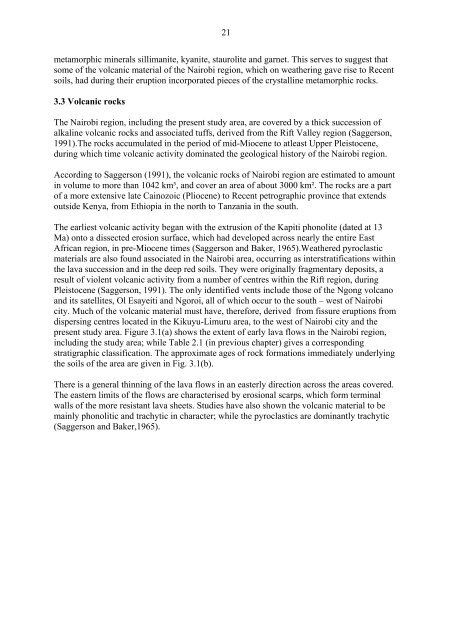an engineering geological characterisation of tropical clays - GBV
an engineering geological characterisation of tropical clays - GBV
an engineering geological characterisation of tropical clays - GBV
You also want an ePaper? Increase the reach of your titles
YUMPU automatically turns print PDFs into web optimized ePapers that Google loves.
21<br />
metamorphic minerals sillim<strong>an</strong>ite, ky<strong>an</strong>ite, staurolite <strong>an</strong>d garnet. This serves to suggest that<br />
some <strong>of</strong> the volc<strong>an</strong>ic material <strong>of</strong> the Nairobi region, which on weathering gave rise to Recent<br />
soils, had during their eruption incorporated pieces <strong>of</strong> the crystalline metamorphic rocks.<br />
3.3 Volc<strong>an</strong>ic rocks<br />
The Nairobi region, including the present study area, are covered by a thick succession <strong>of</strong><br />
alkaline volc<strong>an</strong>ic rocks <strong>an</strong>d associated tuffs, derived from the Rift Valley region (Saggerson,<br />
1991).The rocks accumulated in the period <strong>of</strong> mid-Miocene to atleast Upper Pleistocene,<br />
during which time volc<strong>an</strong>ic activity dominated the <strong>geological</strong> history <strong>of</strong> the Nairobi region.<br />
According to Saggerson (1991), the volc<strong>an</strong>ic rocks <strong>of</strong> Nairobi region are estimated to amount<br />
in volume to more th<strong>an</strong> 1042 km³, <strong>an</strong>d cover <strong>an</strong> area <strong>of</strong> about 3000 km². The rocks are a part<br />
<strong>of</strong> a more extensive late Cainozoic (Pliocene) to Recent petrographic province that extends<br />
outside Kenya, from Ethiopia in the north to T<strong>an</strong>z<strong>an</strong>ia in the south.<br />
The earliest volc<strong>an</strong>ic activity beg<strong>an</strong> with the extrusion <strong>of</strong> the Kapiti phonolite (dated at 13<br />
Ma) onto a dissected erosion surface, which had developed across nearly the entire East<br />
Afric<strong>an</strong> region, in pre-Miocene times (Saggerson <strong>an</strong>d Baker, 1965).Weathered pyroclastic<br />
materials are also found associated in the Nairobi area, occurring as interstratifications within<br />
the lava succession <strong>an</strong>d in the deep red soils. They were originally fragmentary deposits, a<br />
result <strong>of</strong> violent volc<strong>an</strong>ic activity from a number <strong>of</strong> centres within the Rift region, during<br />
Pleistocene (Saggerson, 1991). The only identified vents include those <strong>of</strong> the Ngong volc<strong>an</strong>o<br />
<strong>an</strong>d its satellites, Ol Esayeiti <strong>an</strong>d Ngoroi, all <strong>of</strong> which occur to the south – west <strong>of</strong> Nairobi<br />
city. Much <strong>of</strong> the volc<strong>an</strong>ic material must have, therefore, derived from fissure eruptions from<br />
dispersing centres located in the Kikuyu-Limuru area, to the west <strong>of</strong> Nairobi city <strong>an</strong>d the<br />
present study area. Figure 3.1(a) shows the extent <strong>of</strong> early lava flows in the Nairobi region,<br />
including the study area; while Table 2.1 (in previous chapter) gives a corresponding<br />
stratigraphic classification. The approximate ages <strong>of</strong> rock formations immediately underlying<br />
the soils <strong>of</strong> the area are given in Fig. 3.1(b).<br />
There is a general thinning <strong>of</strong> the lava flows in <strong>an</strong> easterly direction across the areas covered.<br />
The eastern limits <strong>of</strong> the flows are characterised by erosional scarps, which form terminal<br />
walls <strong>of</strong> the more resist<strong>an</strong>t lava sheets. Studies have also shown the volc<strong>an</strong>ic material to be<br />
mainly phonolitic <strong>an</strong>d trachytic in character; while the pyroclastics are domin<strong>an</strong>tly trachytic<br />
(Saggerson <strong>an</strong>d Baker,1965).
















